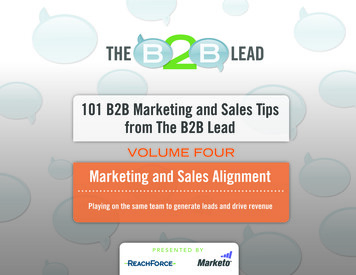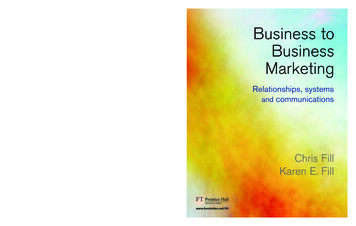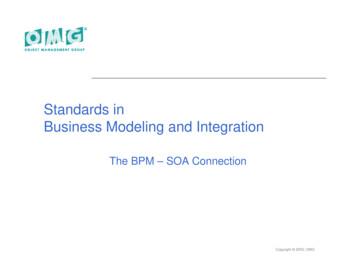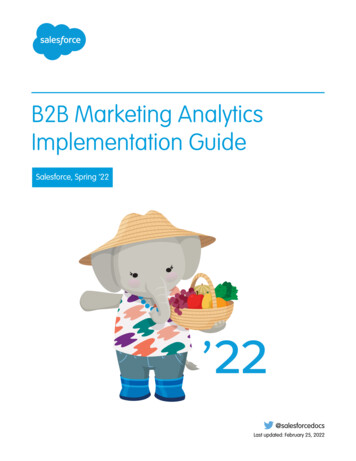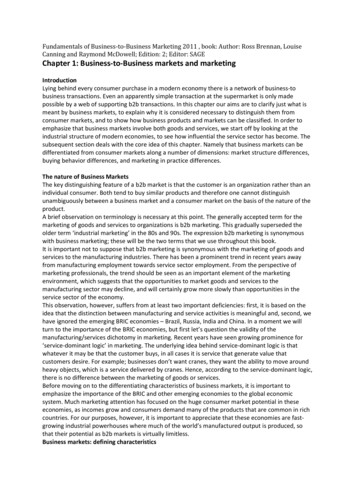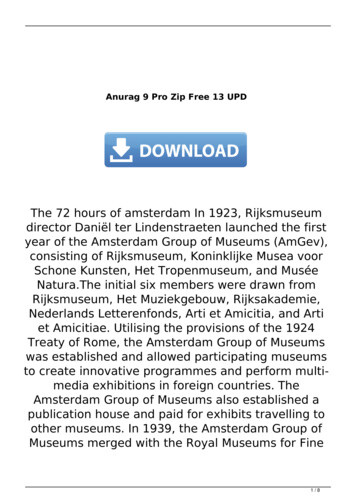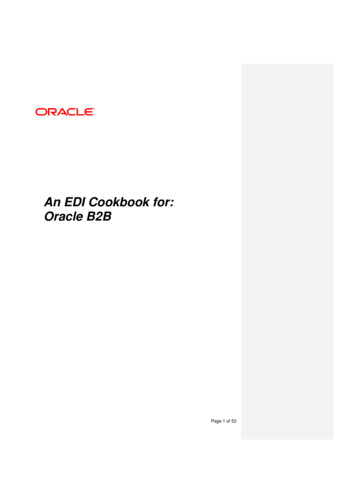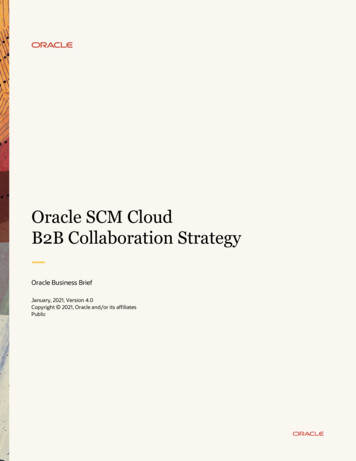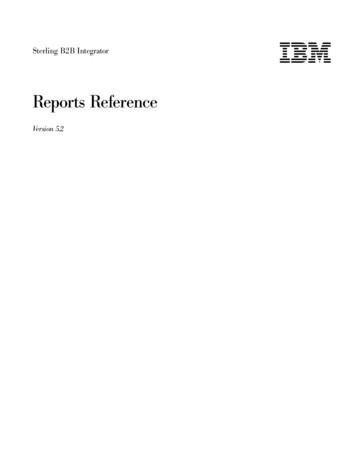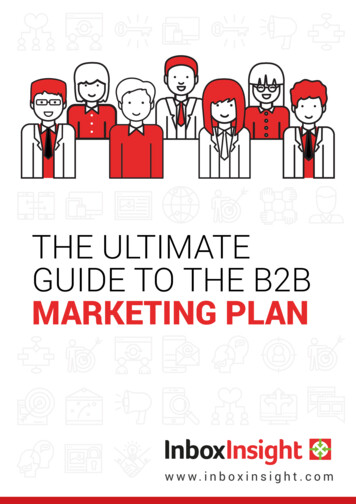
Transcription
B2B MARKETINGDR.V VISHNU VANDANAAssociate Professor1AGI, Hyderabad
Course File IndexS.No.Item DescriptionPageNumber1Course Information Sheet32Syllabus43Text Books, Reference Book, Web/Other Resources54Programme Educational Objectives(PEO’s)65Programme Learning Outcomes(PO’s)66Bloom’s Taxonomy77Course Outcomes(CO’s), Mapping & Articulation Matrix88Course Schedule99Lecture Plan1010Minutes of Course Review Meeting1211Unit Wise Questions1312Case Study1813Previous Question Papers2814Tutorial Sheet3015Course Assessment Report3116Direct Assessment Sheet3217Rubric Name & Number3418Indirect Course Assessment Sheet3619Add-ons , PPT’s & Lecture Notes372
ANURAG GROUP OF INSTITUTIONSVenkatapur (V), Ghatkesar (M), Medchal DistSCHOOL OF BUSINESS MANAGEMENTCourse Name: B2B MarketingCourse NumberCourse DesignationCreditsPrerequisitesA93005M:Marketing Elective:4:MarketingII MBA – I Semester(2018-20)Name of FacultyDr V Vishnu VandanaAcademicYear/RegulationR18Dr.V Vishnu VandanaAssociate ProfessorCourse Coordinator3
Reference BooksSYLLABUSUnit – IIntroduction: Market Opportunity Identification, Analysis & Evaluation, Character of B2BMarketingUnit – IICustomer Analysis: Organizational Buyer Behaviour, Customer Analysis, CustomerRelationship Management Strategies for Business MarketsUnit – IIIMarket Planning: Assessing Market Opportunities, Environmental Changes Impacting SupplyChain Power, Strategic Market Planning.Unit – IVMarketing Mix I: Managing Products for Business Markets, Managing Business MarketingChannels, Pricing, Key Account Management.Unit – VMarketing Mix II: Business Marketing Communication, IMC, Advertising, Trade, PR, One toOne Media, Business Marketing Communication-B2B Branding4
1.2.Vitale, Giglierano, & Pfoerstch, Business to Business Marketing: Analysis and Practice,Pearson/Prentice-Hall, NJ, 2011.Dwyer, F. Robert & Tanner, John F. Jr. Business Marketing, McGraw-Hill, 4/e., 20093.Myers, Chris A., The Marketing Plan Companion: Analysis and Cases, Kendall HuntPublishing, 20134.Michael D Hutt, Dheeraj Sharma, Thomas W Speh, B2B Marketing: A South-AsianPerspective Cengage Learning, 11/e, 20145.Sharad Sarin, Strategic Brand Management for B2B Markets : A Road Map forOrganizational Transformation, Sage publications, 2010.Journals:1. Journal of Marketing Research2. Journal of Business-to Business Marketing, Taylor & Francis Online.Case References:1. asestudies/27/market-researchWebsites References1 https://courses.edx.org/course modes2 Nptel.ac.in3 usiness-marketing.htm5
Learning OutcomesThe learning outcomes specify the knowledge, skills, values and attitudes students are expectedto attain in courses or in a program.1. Business Environment and Domain Knowledge: Graduates are able to improve theirawareness sand knowledge about functioning of local and global business environmentand society.2. Critical thinking, Business Analysis, Problem Solving and Innovative Solutions:Graduates are expected to develop skills on analysing the business data, application ofrelevant analysis, and problem solving in other functional areas such as marketing,business strategy and human resources.3. Global Exposure and Cross-Cultural Understanding: Demonstrate a global outlookwith the ability to identify aspects of the global business and Cross CulturalUnderstanding.4. Social Responsiveness and Ethics: Graduates are expected to identify the contemporarysocial problems, exploring the opportunities for social entrepreneurship, designingbusiness solutions and demonstrate ethical standards in organizational decision making.5. Effective Communication: Graduates are expected to develop effective oral and writtencommunication especially in business applications, with the use of appropriatetechnology.6. Leadership and Teamwork: Graduates are expected to collaborate and lead teams acrossorganizational boundaries and demonstrate leadership qualities, maximize the usage ofdiverse skills of team members in the related context.Program Educational objectives1. To impart the fundamentals of the key elements of a business organization.2. To provide a critical perspective on theoretical knowledge and practical approach tovarious functional areas of management and decision making.3. To develop analytical skills to identify the link between the management practices in thefunctional areas of an organization and business environment.4. To establish and realize a creative research culture among the student community.5. To provide insights into latest technology, business communication, managementconcepts and to built team work and leadership skills among them.6. To inculcate the habit of inquisitiveness and creativeness aimed at self actualization andrealization of ethical practices.6
7
Course Outcomes:1.2.3.4.5.Identify various marketing concepts involved in organizational buying.Comprehend the buying process of business markets.Analyze the opportunities for business to business marketingApply the marketing mix concepts to B2B marketsApply the communication strategies for B2B marketsAfter completion of the course the students will be able to:MAPPING OF COURSE OUT COMES WITH PO’s & culation matrix of Course outcomes with PO’s &PEO’sPEO’SProgram Learning OutcomesCO1PO13PO23CO233PO32PO4PO5PO6PEO PEO PEO PEO PEO123453333CO33CO43CO532PEO62323232232323228
Course ScheduleDistribution of Hours in Unit – WiseUnitTopicUnit – IIntroduction: Market OpportunityIdentification, Analysis & Evaluation,Character of B2B MarketingUnit – IICustomer Analysis: Organizational BuyerBehaviour, Customer Analysis, CustomerRelationship Management Strategies forBusiness MarketsUnit – IIIMarket Planning: Assessing MarketOpportunities, Environmental ChangesImpacting Supply Chain Power, StrategicMarket Planning.Book 1Book 2Vitale,Giglieranoet. al.Dwyer,Tanneret.alCh1, 2Ch 1,10Ch 3, 4, 6Ch 2,310Ch 5Ch 4,5,Unit – IVMarketing Mix I: Managing Products forBusiness Markets, Managing BusinessMarketing Channels, Pricing, Key AccountManagement.Unit – VMarketing Mix II: Business MarketingCommunication, IMC, Advertising, Trade, PR,ChOne to One Media, Business Marketing12,15,16Communication-B2B BrandingTotalTotal No. ofHours10Ch 8.9,14Ch8,9,10,149Ch 11, 12948Number of hours / lectures available in Semester / Year: 609
Lecture Plan:S.NO1.TOPICUnit - I : IntroductionClasses1Teaching methodologyClass activity – Discussion2.Market Opportunity Identification3Activity –student presentations3.Analysis & Evaluation2Chalk & Board , Discussion4.Character of B2B Marketing2Discussion5.Review & Case2Case study & Presentations6.10TotalUnit - II: Customer Analysis: OrganizationalBuyer BehaviourCustomer Analysis3PPT2Chalk & BoardCustomer Relationship Management Strategies forBusiness Markets3PPT10.Review & Case2Presentations & Case study11.Total1012.Unit – III: Market Planning: Assessing MarketOpportunities3PPT & Group Discussion13.2Chalk & Board14.Environmental Changes Impacting Supply ChainPowerStrategic Market Planning.315.Review & Case2PPT & presentations on variouscompany strategiesDiscussions & Case study7.8.9.16.Total10218.Unit - IV: Marketing Mix I: Managing Productsfor Business MarketsManaging Business Marketing Channels2PPT19.Pricing2Chalk & Board20.Key Account Management.1Chalk & Board21.Review & Case2Student presentations22.Total917.PPT10
2PPT24.Unit –V: Marketing Mix II: Business MarketingCommunication,IMC, Advertising, Trade, PR, One to One Media3Presentations25.Business Marketing Communication-B2B Branding2Chalk & Board26.Review & Case2Activity - Plan a b2bcommunication strategy27.Total928.Total Classes4823.11
Minutes of Course Review MeetingDetails of Meeting No Date of MeetingMember’s PresentSignature of MembersRemarksDetails of Meeting No Date of MeetingMember’s PresentSignature ofMember’sRemarksDetails of Meeting No Date of MeetingMember’s PresentSignature ofMember’sRemarks12
Unit Wise QuestionsB2B MarketingUnit I:Short Answer Questions:1. Explain the characteristics of B2B markets. – L22. Differentiate between characteristics of B2B and Consumer Markets.- L43. Illustrate the importance of B2B marketing. – L24. What are the different types of B2B customers? Describe their characteristics. –L25. Discuss recent trends of B2B marketing. – L2Essay type questions:6. What is Derived Demand? Explain various factors affecting Business marketsdemand. L27.How does Industrial Market differ from Consumer Market ? Give examples. – L48. Business-to-business marketers are making increasing use of social media, suchas LinkedIn, Facebook and Twitter. Comment. L49. Explain the process of B2B market opportunity identification. L210. How do you evaluate the B2B market opportunities. Explain with an example. –L411. Elaborate with examples the characteristics of B2B markets and their implicationsto marketing mix. – L512. Discuss the importance of market analysis of B2B markets – L213. Explain the concept of relationship marketing and its phases – L214. How can B2B marketing manager make use of the changing technology toincrease the customer base. Discuss. – L415. Briefly explain target market selection strategies in an industrial market- L216. Briefly explain the different types of competition in B2B marketing withexamples. – L2Unit II :Short Answer Questions:13
1. Discuss briefly about buying roles in B2B buying. – L22. Discuss the nature of B2B customers. – L23. Critically evaluate the factors influencing industrial customers. – L44. . Explain the customer relationship management strategies for business markets.– L25. . Describe the requirements for effective B2B market segmentation. L2Essay Type Questions:1. What is the role of various strategic business units during the industrialmarketing strategic planning process?- L22. What different Purchasing Systems are used in Industrial Buying ? Whatare the merits and demerits of each of them? – L23. Discuss the major buying center roles in an organization.-L24. Differentiate between consumer buying behavior and organization buyngbehavior. – L45. Explain the concept of value chain.- L26. Elaborate the role of the different publics in the industrial marketingenvironment-l27. Outline the major the major buying situation in an industrial market-L2Unit III:Short Answer Questions:1. Illustrate with an example the opportunity identification in the B2B markets.2. Describe the various stages of marketing research. –L23. How do you assess market opportunities in B2B markets. Discuss - L24. Discuss different types of decisions in B2B marketing. – L25. Discuss the characteristics of B2B marketing and consumer market research. – L2Essay Type questions:1. How to develop strategies for success in B2B markets? Explain – L42. Explain the various factors environmental changes impacting supply chain power– L23. What are the challenges faced in value creation in Supply Chain of B2B14
markets. Discuss. – L44. How does market research help B2B markets in assessing opportunities. Discuss.– L35. Differentiate Consumer market research and B2B market research. L46. Elaborate different types of sources of competition to B2B marketing.-L27. Explain various types of forecasting types and techniques in B2B marketing. –L2Unit IV:Short Answer Questions:1. How do you classify industrial products. – L22. Explain the process of new product development. – L23. Explain the process of managing products for business markets. – L24. Discuss the importance and factors influencing pricing in B2B markets.5.Why is it important for firms to nurture relationships with key accounts. Discuss.– L4Essay type questions:1. Explain the stages of Key account management. – L22. Explain factors which affect Channel Decision for Industrial Products. – L23. Discuss different approaches in developing new products. – L24. How does channel management influence various metrics in B2B marketing. – L35. Explain various stages of PLC and how can a company identify the stage of PLC.– L36. Discuss the functions and bases of power in marketing channels. – L27. With an example of any organization discuss the concept of PLC in B2Bmarketing.8. Describe the relationship between pricing and value to the customer. How canyou differentiate through value addition. Give example– L39. Discuss the various components of price setting decision process. – L210. Elaborate on the value based approach for pricing. – L211. Explain various factors influencing the pricing decisions. –L 212. Discuss different pricing strategies with examples – L215
13. Explain the process and strategies while evaluating competitive threat to anorganization. – L2Unit V:Short Answer Questions:1. What is IMC. Why is it important for B2B markets. – L42. Explain various elements of IMC in Business marketing communication and theirsignificance. – L23. Discuss the need and importance of B2B branding. – L24. How does Business marketing communication influences B2B branding. Discuss– L45. Explain the concepts of i) Advertising ii) Tradeiii) One to One MediaEssay type questions:1. “Advertising and Sales Promotion are not the major techniques of PromotingIndustrial Products.” Do you agree ? Justify your answer. – L52. Illustrate the model of communication process and what are thecommunication methods other personal selling in B2B marketing. – L23. Sales promotion can be targeted to different customer categories in B2Bmarketing. Comment.- L34. Explain buying decision process and relevant non personal communicationmethods. – L25. Why do organizations use corporate advertising. Explain. L46. Discuss the role and purpose of web communication in B2B marketing – L27. The role and mechanism of B2B branding is different from consumer markets.Do you agree? Justify. L58. Explain any success stories of B2B branding. – L316
CASES:Case 1:Rising Sun Toyo Ichiura had recently been transferred from the Consumer Electronics to theBusiness Solutions Division of Rising Sun Electronics. The firm is a US 10-billion company,manufacturing every kind of electronic product from TVs to portable CD players. Rising Sun is ahousehold name throughout the world, known for quality consumer electronics products.Recently they have also become interested in serving busi - ness markets and established theBusiness Solutions Division to take their electronic know-how into business markets. Their firstsegments will be related to business com - munications and on-site security. Last year they soldabout 500 million in products and services to business markets but top man - agement expectsthese markets to grow in excess of 20 percent per year. In addition, the margins on businessproducts are at least double those in the consumer markets. After only about three months on thejob as vice president of marketing for Business Solutions, Ichiura was wondering how he couldcarry out his assignment from the CEO. When the CEO hired him, he had said “the marketing inour B2B operations just isn’t what it should be. Since you have extensive experience inmarketing for consumer electronics products, I assume you will be able to determine what wecan do to improve our marketing for Business Solutions.” As Ichiura began to study the BusinessSolutions Division, he came to a few tentative conclusions. First, advertising and promotionreceived little emphasis in this division. Second, marketing for each business seemed to berelevant only to that business, a selfcontained unit. Third, the product managers in thesebusinesses were deeply involved with their customers, sometimes spending weeks at a timeworking on one large customer rather than focusing one common appeal to the largest number ofconsumers. Ichiura decided to discuss his observations with some of his more experienced B2Bcolleagues at RSE. When he described his tentative conclusions, his colleagues surprised him bydisagreeing with them. So he decided to speak to a fellow graduate of Tokyo University he knewwas now working in a B2B position in the steel industry. He was in for another surprise. Aftersome reminiscing, Ichiura broached his subject with his friend Yoichiro Watanabe. He reiteratedhis three major conclusions and asked for advice. Watanabe took a moment to look at the busytraffic in the Tokyo streets below before responding. “Well, it is difficult. While marketing iscalled marketing with consumers and is also called marketing in the B2B world, there are somany differences it is hard to know where to begin. The kinds of tools you used in your previousposition are just the opposite in many cases to what should be done in your current position. Itmight be prudent to put off your deadline for reporting to your CEO and spend some time with17
the major cus - tomers of your division. I believe I know you very well and I know you will beable to learn the nuances of this new field.”CASE STUDY QUESTIONS:1 Was Watanabe wrong? Were the B2B marketing executives at RSE just protecting their pastdecisions?2 What major differences do you think Ichiura will find if he follows Watanabe’s advice?3 Is it a good idea to promote consumer marketing executives to senior B2B marketingpositions?4 Why do advertising and promotion play a subsidiary role in B2B marketing?5 What are the major differences between B2B buyers and consumer purchasers?Case 2:Case study: Tullow Oil PLC Tullow Oil is a bit of a maverick in the oil exploration business.The company was founded in 1985 by an Irish accountant, Aidan Heavey, who thought theremight be potential in small oil fields in Africa that large companies had overlooked. Heaveynamed the firm after the small town about 35 miles south of Dublin where he began thecompany. He started by talking to a friend at the World Bank who knew about a project inSenegal where he could rework some old fields. Tullow has been remarkably successful eversince. They strike oil in about 70 per - cent of their exploration and appraisal wells, double theindustry average. In 2006 the firm discovered a more than 1-billion barrel field in the LakeAlbert region of Uganda and now has operations in more than 20 countries. Tullow’s geologistsuse their discoveries to look for similar geological areas for further exploration. For instance thefirm drilled a well off French Guiana because they believe there are similar oil deposits in LatinAmerica to those in West Africa, since the two continents once made up a single landmass.Tullow involved two major European oil firms in that exploration, Shell and Total, andannounced that they had discovered a large quantity of oil. Their 2011 financial results areimpressive (2010 results are shown in brackets): Sales revenue ( m) 2,304 (1,090): Up 11118
percent Operating profit ( m) 1,132 (262): Up 332 percent Profit before tax ( m) 1,073(179): Up 499 percent Profit after tax ( m) 689 (90): Up 670 percent Basic earnings pershare (cents) 72.5 (8.1): Up 795 percent Full year dividend per share (pence) 12 (6): Up 100percent As the company grows, it faces political, cultural, and environmental challenges. Forinstance, Uganda’s government wants Tullow to join with other firms to build a refinery withinthe country. And the Ugandan gov - ern ment sent a 472 million tax bill to the firm. As thecompany begins to explore in Kenya it is moving into a location where there are many earlyhominid sites. Richard Leakey, the well-known anthropologist, says Mr. Heavey has a very goodattitude toward the responsibilities an oil company should have in that area. Tullow issues anannual cor - porate social responsibility report measuring its CSR efforts. Some problems havebeen discussed in the press. Oil industry analysts at Oxfam America, the global relief anddevelopment organization, said safety and environmental concerns weren’t fully addressedbefore the project was approved. Even though Jubilee field production has started, Ghana has yetto update environmental laws governing extractive industries that were written a generation ago.Ghanaian officials said new legislation will be considered this year. Some are concerned that thisfirst oil project was Ghana’s first major one of any kind. One report says the following:For Tullow Oil and its partners, corporate social responsibility is no more business as usual.They appear bent on departing from the token - istic approach of providing various forms ofservices needed or not, to local communities. Some say, the company is only responding toincreased media attention, pressure from non-governmental organiza - tions, and rapid globalinformation sharing, which have led to a surge in demand from civil society, con - sumers,governments, and others for businesses to adhere to sustainable business practices. But, Tullowsays it is here to demonstrate that it is possible to conduct oil business in a way that benefits all,both companies and resource owners. The company recently organized a free health screeningexercise for local people who were screened for diabetes, HIV, hypertension, breast cancer,dental care, ear, eye, nose, and throat infections. Mr. Ken McGhee, the Corporate SocialResponsibility Manager for the Jubilee part ners [the operators of the large oilfield in Ghana],said the screening exercise was aimed at offering free medical services to inhabitants residingwithin its opera - tional area adding that “the health needs of the people within their catchmentarea would remain para - mount to the company and never be relegated to the back ground.” Atotal amount of 1.6 million has been committed by the Jubilee partners to develop six coastaldistricts of the Western Region. Under a project tagged “Town Planning: an Impera - tive for19
Sustainable Oil economy in Western Region” the capacity of the six districts to professionallycraft develop ment plans to serve as the basis for both structural and human development in theshort to medium term will be enhanced. The company’s website offers much information aboutits Vision and strategies. Vision To be the leading global independ - ent exploration andproduction company. Strategy Tullow pursues a consistent and repeatable strategy which seeksto deliver sustainable long-term growth with a balance between funding, exploration andproduction spend, and major activities in core areas. Strategic Priorities 1 Execute selective,high-impact exploration programmes funded by surplus cash flow or equity. 2 Deliver majorprojects, with a significant focus on increasing bankable reserves. 3 Manage our assets to highgrade the portfolio, replenish upside, and assist funding needs. 4 Ensure safe people, proceduresand operations, and minimizing environmental impacts. 5 Build long-term relationships withgovernments, local com - mun ities and key stakeholders. 6 Continue to develop a strong teamwith excellent com mer - cial, technical, and financial skills. Overall, Tullow’s approach seemsresponsive to the needs of the twenty-first centuryCASE STUDY QUESTIONS1 Do Tullow’s vision and strategies meet the requirements described in the chapter?2 How is Tullow’s lack of a mission statement important to the future success of the firm?3 How do resources, industry, and institutional considerations affect Tullow’sstrategy?4 What type of globalization strategy do you think Tullow has adoptedCase 3: Segmentation, Targeting and positioningNorthern Portugal is the cradle of the nation’s entrepreneurial spirit. Business people in theregion consider themselves to be the real wheeler-dealers of the Portuguese economy, runningmainly small- to mediumsize businesses, and having a certain air of contempt for theircounterparts in Lisbon and further south. According to the northern Portuguese, Lisbonites aremere employees of multinationals who spend their time on politics and parties while the realdeals are done in the North. Of course, in common with most other capital cities, Lisbon is wherethe power and money gravitates; like the multinationals, banks have a strong presence there.However, the Portuguese have a saying that banks are born in Oporto and die in Lisbon, wheredeal-making skills become blunted and atten - tion to detail becomes lax. For this reason, BancoPortugues de Investimento keeps its headquarters in Oporto. BPI is an exclusive merchant bankset up in 1981 by Artur Santos Silva; Senhor Silva subsequently set up or acquired a string of20
subsidiary banks between Oporto and Lisbon. Two of these, Banco de Fomento e Exterior andBanco Fonsecas & Burnay, have head offices in Lisbon, while a third, Banco Borges & Irmao,remained in Oporto. Borges & Irmao was focused toward Northern Portugal, which is where thebulk of its branches were, and Fonsecas & Burnay was focused in the south. Later these bankswere subsumed into the overall brand of Banco BPI, but since Allianz Bank (a German bank)bought part of the bank, BPI has also traded as Allianz Portugal. Bank managers have beenbriefed to develop consumer lending niches such as credit cards and car purchase loans,segments where BPI claims it has developed key prod - ucts. The business in the North has theadded bonus of using its retail activities to scout for corporate finance – so many of its retailcustomers are business people running small and medium enterprises. Typically, banking groupsin Portugal divide their markets into three main segments; small and medium enterprises,universal banking, and large corporations. BPI believe that the delivery of tailor-made services tospecific segments is the key to success in domestic banking. Banking executives are painfullyaware that there is a lot of work to be done in restructuring the industries of Northern Portugal –they talk in terms of identifying products and standardizing them, of joint marketing projects,and of pooling companies together for research and testing of projects. Aiding management buyouts and merger and acquisition deals are seen as ways of ensuring continuity in businesses, andbanks are looking toward cross-border transactions with companies in Northern Spain as a wayof consolidating businesses. So far progress has been slow – obviously the economic problemsfaced by Portugal have called a halt to business expansions, but also there have been few largeenterprises emerging from the spate of mergers and acquisitions. Most firms are still engaged intraditional industries such as leather production, agriculture, and textiles, all of which face stiffcompetition from lower-cost producers in other countries. Meanwhile, BPI has developed astrong position in Africa: the former Portuguese col - onies of Angola and Mozambique areamong the economic powerhouses of Southern Africa, and BPI has a stake in their growththrough shareholdings in local banks there. This has helped cushion the bank from the 2008world financial crisis: Mozambique is among the world’s fastest-growing econ - omies, withburgeoning chemical and manu - facturing industries as well as traditional agriculture andmining, and Angola has great mineral wealth (including diamonds) which will eventuallycatapult the country into becoming one of the wealthiest in Southern Africa. BPI is well-placedto take advantage of this, once the current political troubles are over, and in November 2010 thebank signed an agreement with the Bank of China under which BPI will assist China in creating21
inward investment by Chinese companies in Portugal and Portuguese Africa. The two banks willalso cooperate on cross-border trade settle ments, funding of major projects, and day-to-daybanking issues such as letters of credit, documentary collections, and capital management.Questions:1 How does BPI appear to have segmented its market? a. What variables have they used?2 Why should an investment bank look to have a foothold in the consumer market?3 What do you think are the drivers behind Bank of China’s interest in BPI?4 How might the company segment the African market? 5 Which segments should BPI avoid? 6What could an effective positioning strategy be for BPI?Case Study 4: Toshiba – Product Managementare extremely useful anywhere where weight and size are a problem. The company has a policyof running regular research sessions with customers to uncover new needs and refine existingproducts. This research ranges from inter - views to questionnaires, and the results are taken veryseriously indeed – as a direct result of Toshiba’s discussions with customers, the followingchanges were made in recent years: Exposure to X-rays from Toshiba medi - cal equipmentwas halved. Shock-resistant mobile PCs were de - veloped following observation of howpeople handled the equipment. A 0.85-inch hard disk drive was de - veloped for use inminiature computers (palm tops) and portable GPS units. Recently, the company has started touse questionnaires sent to mobile telephones of customers. This has increased response ratesdramatically – often several thousand responses come in from each questionnaire, giving thecompany some extremely rapid feedback on new products. As in its new product development,Toshiba wants to be at the forefront of technology in its customer research. For the past 130years, Toshiba has maintained engineering excellence without losing sight of customer needs. areextremely useful anywhere where weight and size are a problem. The company has a policy ofrunning regular research sessions with customers to uncover new needs and refine existingproducts. This research ranges from inter - views to questionnaires, and the results are taken veryseriously indeed – as a direct result of Toshiba’s discussions with customers, the followingchanges were made in recent years: Exposure to X-rays from Toshiba medi - cal equipmentwas halved. Shock-resistant mobile PCs were de - veloped following observation of howpeople handled the equipment. A 0.85-inch hard disk drive was de - veloped for use inminiatur
Unit -V: Marketing Mix II: Business Marketing Communication, 2 PPT 24. IMC, Advertising, Trade, PR, One to One Media 3 Presentations 25. Business Marketing Communication-B2B Branding 2 Chalk & Board 26. Review & Case 2 Activity - Plan a b2b communication strategy 27. Total 9 28. Total Classes 48
